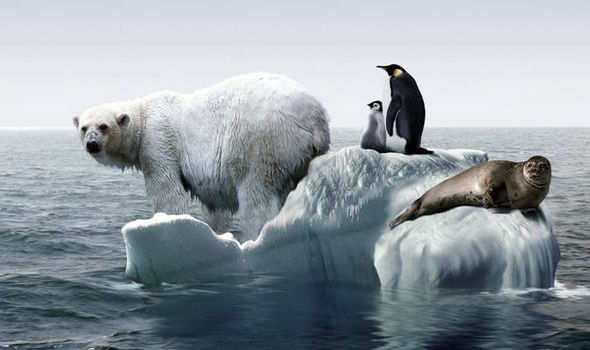There is so much quotable news in the article below I don’t know where to start. Basically, this piece consolidates many of the warnings I’ve been writing about forever. The main points:
-
A warming planet will melt glaciers and ice sheets around the world.
-
This will lead to sea level rise that will put costal communities in grave danger in a multitude of ways.
-
Changing temperature and salinity of the oceans will also cause massive changes in weather worldwide.
-
The longer we wait and slower we change the quicker and greater the devastating consequences will be.
“The thing that surprised me most was the scale of climate impact from actually a small amount of ice loss. You don’t need to lose much ice from the ice sheet before you see tangible effects on the climate.”
“melting ice in Antarctica has global consequences that extend far beyond sea level rise and into the overall climate system. These ripple effects stand to exacerbate extreme weather events that can hit people far from the shore.”
“it could lead to sea levels that are 3 feet higher by 2100, wiping out coastal metropolises around the world.”
“a massive torrent of cold, fresh water gushing into the ocean has major consequences that go beyond the world’s coastlines.”
“sea level rise won’t just cause displacement — it’ll also increase nuisance flooding, saltwater intrusion, and higher storm surges during hurricanes. We’re already seeing these kinds of disruptions around the world, devastating homes, livelihoods, and costing thousands of lives. But millions more will face greater risks as the planet continues to warm.”
“Meanwhile, the Himalayas and the Hindu Kush, the tallest mountain ranges in the world, also received a dire prognosis for their ice this week. The region is home to so much permanent ice it’s referred to as the “Third Pole.” Though the glaciers in these mountains are tiny compared to the expansive ice sheets of Greenland and Antarctica, they directly affect the lives and livelihoods of the 250 million people who live in the mountains and the 1.6 billion people who drink its water.”
“a phenomenon known as the Atlantic Meridional Overturning Circulation shunts warm temperatures from the Gulf of Mexico to Europe. If you’ve ever wondered why Marseille, France is at a higher latitude than New York City but has a warmer climate, this is why.
“With the oceans, you are moving a lot of heat around the globe,” said Golledge.
Earth’s oceans circulate along gradients of hot and cold as well as salty and fresh. Golledge found that ice melt runoff from Antarctica, Greenland, and even inland glaciers like those in the Himalayas can throw off these circulation patterns.”
How Antarctica’s Melting Ice Could Change Weather Around the World
New research shows that melting ice will lead to more trapped heat in some regions and colder temperatures in others.
By
A glacier descending from Anvers Island into the Neuymayer Channel in Antarctica. The continent is losing ice at an alarming rate, threatening shorelines around the world. Mark Brandon
Nearly 2.4 billion people, or 40 percent of the world’s population, live within 60 miles of the ocean. And so it’s clearly not good that higher average temperatures are causing water in the ocean to expand. Hotter weather is also melting ice on land, increasing the volume of water in the ocean.
Scientists are now paying particularly close attention to warming in Antarctica, home to 90 percent of our planet’s ice. If it were all to melt, it would raise sea levels by 190 feet. Oceans have already risen more than 8 inches since 1880, and between 1992 and 2017, Antarctica lost 2.71 trillion metric tons of ice. This is roughly the volume of three Olympic-size swimming pools every second. Half of these losses came in the last five years, a sign of an accelerating melt rate.
:no_upscale()/cdn.vox-cdn.com/uploads/chorus_asset/file/13739972/Golledge_image_1.jpg)
The Renegar Glacier in the Transantarctic Mountains. Once considered inert, the East Antarctic Ice Sheet is now showing increasing signs of change. Nick Golledge
The big question then is what humanity should expect in the future as temperatures continue to rise. In two new papers published Wednesday in the journal Nature, scientists narrowed down the scenarios for sea level rise stemming from melting ice in Antarctica.
They found that the evidence for some of the more dire forecasts for sea level rise, upward of 3 feet by the end of the century, is not as robust as once thought. However, they report that melting ice in Antarctica has global consequences that extend far beyond sea level rise and into the overall climate system. These ripple effects stand to exacerbate extreme weather events that can hit people far from the shore.
It’s a critical reminder that warming in even the coldest, most remote parts of the planet can have global consequences. Since scientists still have much to learn about Antarctica’s ice, they are now in a race to learn as much as possible as it melts away before their eyes.
Scientists are getting better at estimating how high oceans will rise as Antarctica melts
Average global temperatures are closely related to the amount of heat-trapping gases like carbon dioxide people pump into the sky, and climate researchers use this mechanism to anticipate future warming. However, predicting sea level rise as the climate changes is much more difficult because there are so many local and global factors at play. “There’s always been quite a lot of uncertainty in sea level rise because it’s hard to figure out how ice sheets behave,” said Tamsin Edwards, a lecturer in physical geography at King’s College London in the United Kingdom.
Edwards, the lead author of one of the Nature papers published Wednesday, decided to examine a particular kind of ice loss in Antarctica known as marine ice-cliff instability to try to get more clarity. Ice cliffs are the craggy sides of the ice sheet that can tower more than 300 feet high.
An alarming 2016 paper theorized that when these cliffs extrude over coastal waters, warming air and warming water could cause them to catastrophically collapse under their own weight. The fractured ice would then thaw and contribute to sea level rise, which would then melt more ice.
According to the 2016 paper, this mechanism explains the rapid rise in sea levels we saw near the end of the last ice age. If it comes into play in our current era of warming, it could lead to sea levels that are 3 feet higher by 2100, wiping out coastal metropolises around the world.
:no_upscale()/cdn.vox-cdn.com/uploads/chorus_asset/file/13739970/067_Stange_Ice_shelf.jpg)
The Stange ice shelf in the Ronne Entrance, Southern Bellingshausen Sea along the Antarctic peninsula. Mark Brandon
However, in her analysis of several different models, Edwards found that she could model past sea level rise events without incorporating this mechanism in a way that aligned with the paleoclimate record. “We found that we just didn’t need this feedback to explain the past,” she said.
That doesn’t mean that ice cliffs won’t become unstable in the coming decades, but the evidence that such a phenomenon would occur is weaker. The results are helping scientists zero in on a more precise estimate of sea level rise by bracketing out some of the more extreme projections. Many models are now starting to converge around a sea level rise estimate below 16 inches by the end of the century. That would still be a radically reshaped world, but likely not as calamitous as 3 feet of sea level rise.
“We know more than we did, and we’re starting to agree more than we used to,” Edwards said.
Sea levels aren’t the only mounting concern from melting ice
Nicholas Golledge, an associate professor at the Antarctic Research Centre at Victoria University of Wellington in New Zealand and the lead author of the second Nature paper, explained that a massive torrent of cold, fresh water gushing into the ocean has major consequences that go beyond the world’s coastlines.
While we may think of weather as something that happens in the sky, the ocean plays a big role in how temperature and rainfall are distributed across the planet. El Niño, for instance, is a periodic warming pattern in the Pacific Ocean that can bring more rain to Peru and drought to Australia. Similarly, a phenomenon known as the Atlantic Meridional Overturning Circulation shunts warm temperatures from the Gulf of Mexico to Europe. If you’ve ever wondered why Marseille, France is at a higher latitude than New York City but has a warmer climate, this is why.
“With the oceans, you are moving a lot of heat around the globe,” said Golledge.
Earth’s oceans circulate along gradients of hot and cold as well as salty and fresh. Golledge found that ice melt runoff from Antarctica, Greenland, and even inland glaciers like those in the Himalayas can throw off these circulation patterns.
YOU DON’T NEED TO LOSE MUCH ICE FROM THE ICE SHEET BEFORE YOU SEE TANGIBLE EFFECTS ON THE CLIMATE.
We’re already seeing signs that the AMOC is slowing down, disrupting the Gulf Stream, and fueling colder winters and hotter summers in the North Atlantic. Changing water temperatures and nutrient flows are also harming fisheries for important commercial species like cod.
A further slowdown will likely lead to more extreme weather in Europe. And there could be a tipping point ahead where the AMOC abruptly shifts, leading to climate disruptions that will ripple across the planet, trapping more heat in some regions and bringing cold temperatures to others. A sluggish AMOC can also lead to higher regional sea levels in areas like the Eastern United States.
:no_upscale()/cdn.vox-cdn.com/uploads/chorus_asset/file/13739964/Screen_Shot_2019_02_05_at_8.04.18_PM.png)
Expected changes in temperature variability by 2100 compared to 2000 under the current greenhouse gas emissions pathway.
“What we’re showing in our paper is [the AMOC] will weaken further as the ice sheet melt from Greenland continues to pour into the North Atlantic,” he said. “The thing that surprised me most was the scale of climate impact from actually a small amount of ice loss. You don’t need to lose much ice from the ice sheet before you see tangible effects on the climate.”
For Antarctica, weaker ocean circulation will likely trap warmer water close to the ice, creating a feedback mechanism that leads to more ice loss. Some of these losses are already baked into the climate system from climate change. But ice sheets may take years, if not decades, to fully respond to the 2.6 million pounds per second of carbon dioxide we’re pumping into the atmosphere.
“What we do right now is really going to dictate some of the longer-term responses from the ice sheets,” Golledge said. “We’re still committed to an ongoing loss from West Antarctica. Really, the question we have is how much worse do we want to make it.”
The combined findings of the two studies show that Earth is going to change substantially, even if it won’t get as bad as some previous research suggested.
“What these studies are showing is that we have a lot of evidence and a whole bunch of studies that suggest that we’re in store for tens of centimeters of sea level rise at the lower end, possibly more,” said Jeremy Bassis, an associate professor at the University of Michigan who studies ice dynamics and was not involved in either study. “It’s enough to displace communities and we have to think about how we’re going to protect our most vulnerable populations that are going to be exposed to sea level rise.”
And of course sea level rise won’t just cause displacement — it’ll also increase nuisance flooding, saltwater intrusion, and higher storm surges during hurricanes. We’re already seeing these kinds of disruptions around the world, devastating homes, livelihoods, and costing thousands of lives. But millions more will face greater risks as the planet continues to warm.
A grimmer picture of ice melt is coming into focus, but we can still do something about it
Scientists late last month also announced that they found a gargantuan void beneath West Antarctica’s Thwaites Glacier, large enough to hold two-thirds of Manhattan. In a study published in Science Advances, researchers reported that the cavern represents the loss of 14 billion tons of ice. The Thwaites glacier alone accounts for 4 percent of global sea level rise and if enough of it melts, it could collapse. Models project that could happen in the latter half of this century.
Meanwhile, the Himalayas and the Hindu Kush, the tallest mountain ranges in the world, also received a dire prognosis for their ice this week. The region is home to so much permanent ice it’s referred to as the “Third Pole.” Though the glaciers in these mountains are tiny compared to the expansive ice sheets of Greenland and Antarctica, they directly affect the lives and livelihoods of the 250 million people who live in the mountains and the 1.6 billion people who drink its water.
According to the Hindu Kush Himalaya Assessment published Monday, the region could lose two-thirds of its glaciers if the planet keeps warming at the same rate. If humanity manages to cap warming at 1.5 degrees Celsius, glaciers in the mountains would still decline by one-third. That would lead to huge declines in drinking water and irrigation for agriculture in one of the most densely populated spaces in the world.
Which scenario actually plays out hinges on what the world will actually do to address climate change, and that remains the largest source of uncertainty in climate models. “What we’re going to do with CO2 and how that’s going to effect [climate] forcing, that’s the biggest unknown and that’s actually the thing we have the most control over,” said Bassis.


/cdn.vox-cdn.com/uploads/chorus_image/image/63008350/082_Neuymayer_Channel_icefront.0.jpg)

